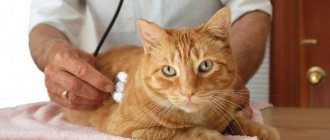Methods of euthanasia - from carbon monoxide to decapitation
In world practice in the 21st century, animals are killed in a variety of ways:
- beheaded (decapitation);
- use electric current;
poisoned with carbon dioxide or carbon monoxide;
- air embolism is used (air is introduced into the circulatory system);
- electrocuted.
None of the listed methods can be considered humane, although in America gas is used on fur farms and to kill stray animals.
International human rights organizations consider the agents used for anesthesia to be the most suitable for euthanasia of pets.
In what cases is euthanasia possible without medical indications?
We are talking about euthanizing a healthy animal. How possible is it? Actually possible. And this is not just euthanasia at the whim of the owner, it can be considered forced. Reasons for this:
- aggressive and dangerous behavior of the animal. These may be wild animals that do not obey humans, attack at the first opportunity, and pose a threat to society;
- injuring or even killing a person;
- being in the center of a terrible infection, the opportunity to act as a carrier of the disease;
- testing of chemical or biological weapons.
Ditilin
Muscle relaxant with depolarizing action. In veterinary practice it is used to immobilize animals. In the Russian Federation it is used to euthanize stray cats and dogs.
Should be used only after the animal has previously been put into medicated sleep. In the Russian Federation, it is often used independently - this is an inhumane method that causes severe suffering. Stopping breathing occurs when the animal is fully conscious.
For euthanasia, you can always contact our service in Moscow!
The drugs Listenol and Arduan have a similar effect to Ditiline. They are used in the second stage of euthanasia.
If your veterinarian suggests euthanasia using Dithiline or similar products, you need to make sure that your pet is put to sleep first.
Euthanasia (euthanization) of animals. On the verge of a controversial decision
We all want our pets to live happily ever after. But... old age comes, and with it a moment may come when our pet’s health fails, and he enters into an unequal battle with a fatal disease.
You will, of course, try to do everything possible to reduce the suffering of your pet, but sometimes you have to think about the need for a terrible decision.
Intentional medicinal termination of an animal's life (active euthanasia, euthanasia) is a painful point for both veterinarians and animal owners. The debate about whether “euthanization” itself is humane or not does not subside among animal lovers for a single day. Many people who want to study to become a veterinarian can be stopped on this path by the thought of having to forcefully end the patient’s life.
Today I want to express my opinion on this topic. I believe that as a practicing doctor with two decades of medical experience, a teacher of medical ethics and deontology at RUDN University and the owner of two cats, I have every right to do this. And, moreover, I consider this my responsibility.
What is animal euthanasia?
Euthanasia (from the Greek εὖ - good + θάνᾰτος - death) is the practice of ending the life of a person or other living creature suffering from an incurable disease, experiencing unbearable suffering.
In veterinary medicine, euthanasia is much more widespread than in humane medicine. First of all, because, according to the legislation of our country, the animal is the property of the owner and it is he who has the right to decide whether the pet should live or die.
Euthanasia can be active or passive.
Passive euthanasia is the absence of active actions by the owner or other interested parties to combat the disease and maintain the life of a living organism (animal or human).
Active euthanasia is the deliberate use of medication to end a patient's life. In this case, the person administering the drug is the executor, and euthanasia itself is carried out by the person who made this decision.
Please note that not helping a sick animal is also euthanasia, only passive. Often this type of euthanasia brings the patient the same suffering that he would experience if the person (the owner) were not there at all, and sometimes even greater. After all, a loved one is nearby, the pet is relying on him, but he does not come to the rescue.
Failure to provide assistance to your pet suffering from a fatal disease is passive euthanasia, leading the animal to suffering and death.
Thus, it turns out that either we are trying to treat and/or maintain the quality of life of our animals with serious illnesses, relieving them of suffering to the best of our strength and capabilities, or, consciously or unconsciously, we are engaged in euthanasia, sometimes passive, sometimes active.
Next we will talk about active euthanasia, leaving the issues of passive euthanasia on the conscience of each animal owner.
Indications for active euthanasia
Euthanasia is not murder, i.e. violent unlawful deprivation of life, but a medical action that relieves the patient of suffering caused by a serious illness. Therefore, the decision on euthanasia should be made not on the basis of emotions or third-party advice, but on the basis of medical indications for this manipulation, i.e. in the presence of irreparable suffering that is incompatible with the concepts of humanity.
Indications for euthanasia can be absolute and relative.
Absolute indications include those conditions that cause the patient’s suffering, which cannot be eliminated by modern means and methods if his life continues, or a long, painful death:
- Extensive tumor growth and/or metastasis of neoplasms to internal organs, leading to severe disturbances in the functioning of internal organs and severe pain attacks.
- Incurable dysfunction of vital organs - heart, brain, lungs or airways, liver or kidneys with attendant suffering of the patient
- Unrecoverable consequences of injury or disease of the brain and spinal cord, making it impossible for the patient to perform vital functions
- Severe pain associated with the performance of vital functions. For example, unremovable pain when breathing with metastatic pleurisy
- Severe irreparable systemic damage causing patient suffering and inability to maintain an acceptable standard of living
But there are also relative indications related to the fact that there are no or insufficient resources to eliminate the patient’s suffering, despite the fact that they, in principle, have been developed.
In most cases, this is due to the high cost of eliminating suffering, the capacity of available veterinary institutions, or the limited resources of time or effort that the owner can devote to caring for a sick animal.
Here are examples of such relative indications for euthanasia:
- The impossibility of constant care for an animal with a severe spinal injury (vertebral fracture) and an ascending urinary tract infection means the owner’s time, energy and resources are running out, and only the animal’s suffering lies ahead.
- Convulsive syndrome in a large dog with manifestation of aggression due to a brain tumor in a small apartment with small children.
- Constant screams of an old cat with a severe form of renal failure, which prevents apartment residents and neighbors from sleeping, and which cannot be eliminated with medications available to the owner, or the cat turns into a “vegetable.”
In these situations, of course, it would be possible to place the animal in a hospital, where the animal could exist until its natural death, but this is very expensive and unreasonable, because recovery in such cases cannot be achieved using modern methods. In similar cases, someone else may be able to “delay” the survival of such an animal, but the owners’ resources are often very limited.
In these cases, euthanasia only shortens the period of joint suffering of the pet and its owner from the manifestations of a serious illness of the animal, but does not change possible medical prognoses.
"Nature" or humanism?
Opponents of active euthanasia may argue that in nature no one euthanizes sick animals and this, they say, is much more correct.
But under natural conditions, there are much faster and more effective ways of euthanizing sick individuals than our human medications.
The first “euthanasia specialists” are, of course, predators. What kind of predator would miss a prey that is weakened and does not resist?
If the predators did not get to the sick animal, then the biggest “euthanasia specialists” - hunger and cold - will certainly get it. The inability to get food for oneself will gradually deplete the patient’s strength, and low temperatures (if any) will significantly accelerate the process of natural “falling asleep” from hunger. Here you have real euthanasia by the forces of nature.
Caring (and not so caring) owners deprived their pet of the opportunity to become a victim of a predator. They try to feed the sufferer, as they say, “until his last breath.” And if they can’t do it themselves, they call in doctors.
Thus, we ourselves deprive our pets of the natural right to die without waiting for terrible suffering.
This means that the responsibility falls on us to save them from suffering when we are no longer able to do anything else.
Methods of active euthanasia
As pathologists say, there are only two true causes of death: cardiac arrest or cessation of breathing. The rest is the conditions for the occurrence of one reason or another.
Therefore, drugs to end life either stop cardiac activity or relax/paralyze the respiratory muscles. There are quite a lot of such drugs. But doctors use only a few for euthanasia.
Why is that? Access to most life-threatening drugs is limited in some way. Either legally regulated access to such drugs, or the dose that must be administered to the patient for the expected effect to occur. After all, a large overdose of most medications, as a rule, can cause additional side effects. Therefore, using them for euthanasia can be simply inconvenient. But in some cases, for lack of a better option, the doctor can use any of them.
But the use of these drugs during euthanasia is only the second step.
To ensure that the patient does not experience additional suffering before death, specialists performing euthanasia at the request of their owners usually first use means that turn off the patient's consciousness. In this case, the termination of life occurs painlessly and is not accompanied by additional suffering to the animal.
How to choose a doctor who performs the euthanasia procedure “according to all the rules”
The best way is to use the services of a long-known and “trusted” doctor. But it happens that for some reason this is impossible. Then the owner sits down at the computer and phone.
And here the worried owner has a considerable chance of falling into the trap of scammers. Treating animals is very difficult, but offering euthanasia is much easier. Especially if you don’t worry about ethical issues.
What should you ask in order to understand whether you should trust a specialist with your suffering pet?
Some animal lovers who are knowledgeable about the procedure advise those involved in the decision on euthanasia to find out in advance from the doctor called for euthanasia what drugs the specialist is going to use. This advice is like a “double-edged sword.”
On the one hand, nothing prevents the on-call doctor or the administrator taking the call from misinforming the client, and if anything happens, simply refer to the fact that they were confused, for example, out of habit. On the other hand, if a person is not a specialist, then the name of the drug will only give him the opportunity to read the instructions for the named drug, and does not at all guarantee the effect expected from the doctor’s actions.
The names of drugs given over the phone do not guarantee the quality of the euthanasia procedure.
Therefore, it is better to clarify over the phone not what kind of drug the doctor uses, but how the procedure itself goes, and what happens to the animal after each action of the doctor. In addition, be sure to inquire about the full cost of the expected procedure.
How to protect yourself from scammers who offer euthanasia?
Some fraudulent doctors answer the question “how much does euthanasia cost?” over the phone they only name the cost of the second step of euthanasia, i.e. administering a drug to end the life of an animal.
And before you take the first step, i.e. turning off the patient's consciousness, they tell the owners how much it costs extra. Frightening at the same time that in the absence of additional payment, the death of the animal will be painful. Or they simply enter several successive steps into the receipt, each with its own amount.
When asked about the cost, the scammer can only name the cost of the main step of euthanasia, and the final amount will be much higher.
In this case, the client may pay exorbitant prices for euthanasia.
How to deal with this? Very simple - precisely posed questions.
It is better if the question about the cost of the procedure sounds like this: “How much should I have with me to pay for ALL the services of your doctor?” And don’t forget to clarify exactly what actions the doctor is going to perform, and what you can expect from these actions.
And to enhance the effect, you can warn the person accepting the call that there will not be a penny more in your house - you will specifically withdraw the required amount from the card of your husband/wife/mother/child, etc., which will then leave with the owner. A conversation like this should be recorded on a voice recorder.
Record conversations with a representative of a veterinary service with whom you have never had any dealings before, just in case - this can protect you from scammers.
In this case, if a representative of the scammers talks to you, he will be forced to voice the entire required amount or refuse the call.
Procedure for euthanasia
Essentially, all methods of active medical euthanasia come down to two sequential steps:
- The use of an anesthetic, sleeping pill or hypnotic to turn off the patient’s consciousness. Depending on the patient's condition, such drugs are usually administered intramuscularly or intravenously.
After using this drug or a combination of drugs, your pet should fall asleep: breathing will change (usually it deepens), reactions to external stimuli will stop, and the animal will relax.
- Use of a drug to stop breathing or cardiac activity. This drug is usually used intravenously, intrapulmonarily or intracardiacly - if access to the veins is difficult.
After using this drug, the animal’s heartbeat and breathing should stop, the mucous membranes begin to take on a hue from bluish to gray-white, and the sphincters (circular muscles) of the natural orifices relax. Single or multiple convulsive contractions of individual muscle groups are possible within the next 10-15 minutes from the moment the drugs take effect.
What to do next?
After euthanasia, according to veterinary standards, you should send your pet's body for cremation. The owner, depending on financial capabilities and personal desires, can choose between individual and group cremation.
Group (general) cremation is carried out by special enterprises commissioned by state veterinary services. You can hand over the body for cremation through a special service or directly through the animal disease control station. Whether or not to open the body before cremation to establish a post-mortem diagnosis is up to the owner to decide.
An autopsy of an animal's corpse is mandatory if, within 10 days before death, the animal bit a person or showed neurological symptoms - due to the risk of rabies.
The owner orders individual cremation for additional money from services that provide similar services. Try to make sure in every available way that this is not a scam!
Ask your loved ones for help!
Euthanasia of a pet is usually a very painful procedure for its owner. To maintain composure in this difficult environment, it is important to remember that by making the decision to actively euthanasia, you are putting your pet out of suffering and doing what Mother Nature would have done for you long ago. In addition, it is worth understanding that your pet is sensitive to your condition and is worried about what is happening to you.
As a rule, the situation is aggravated by the pet’s previous serious condition, the owner’s sleepless nights, and the very process of making such a difficult decision. This, unfortunately, does not contribute to a calm and balanced state of the animal owner.
Therefore, during this procedure, someone close to you must have a clear consciousness and an attentive gaze so that the upset person and his suffering pet do not become a victim of scammers.
When turning to a specialist for the euthanasia procedure, it is worth having a trusted doctor or at least having a clear idea of what and how the doctor should do for euthanasia to truly relieve your pet from the suffering caused by the disease.
If you are in a situation where you need to make a decision to euthanize your beloved animal, do not hesitate to ask for help from a loved one, friend, or even just a neighbor to help you get through this sad situation with the least emotional and financial losses for yourself.
We sympathize with the owners of the sufferers and wish strength to those who are on the verge of deciding to euthanize their beloved animal.
Natalya Troshina, veterinarian (DVM)
How to cope with the loss of a pet?
Many owners suffer greatly after losing a pet. This is normal, because the dog has become more than just an object of leisure. After the death of a friend or family member, there is no need to bottle up your emotions and suffer alone. A funeral ceremony should be held, and there should be a lot of crying and grieving. At the same time, there is no need to fall into apathy and depression. You need to find the strength to let go of the animal and move on.
If a person is not ready to adopt a new dog, you can become a volunteer. Taking care of other animals will help you take your mind off the loss and preserve in your memory joyful moments with your departed friend. Psychological support from other people who have experienced a similar situation helps most effectively.
Recommendations from veterinarians and breeders
The vast majority of people who have a relationship with dogs, who love them as members of their family, agree that you should not make your pets suffer.
If such a disaster occurs, then it is wiser to decide on humane euthanasia than to allow yourself to selfishly torture a dog that gave you love and devotion.
But with all this, none of these people would recommend euthanasia on their own, at home. This is due to the impossibility of freely purchasing the necessary medications and/or veterinary drugs and the lack of skill in intravenous injections among most people.
If these requirements are not met, euthanasia essentially ceases to be euthanasia and becomes cruelty to the animal.











